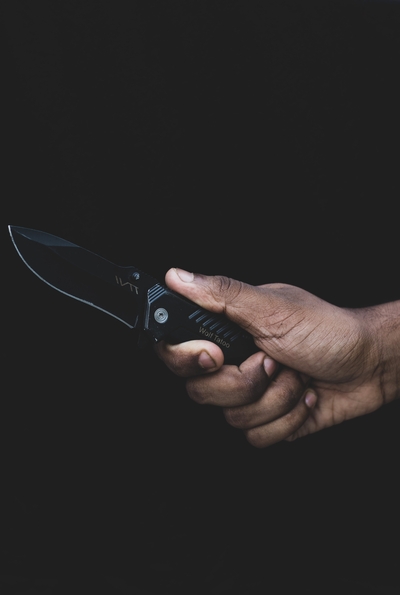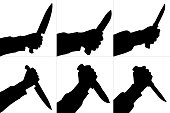
Whenever we think of self-defense, the first type of weapon that comes to mind is firearms.
However, we tend to overlook pocket knives. The secret to using an EDC pocket knife effectively as a weapon relies on skill.
Highly skilled people find knives an excellent self-defense weapon — sometimes even better than guns.
For EDC pocket knife lovers, this is the time to learn how to actually use that item you admire — you never know when it comes in handy.
What Makes a Pocket Knife Ideal for Self-Defense?
In a nutshell, a pocket knife is ideal for self-defense because of how small and easy it is to carry.
Although larger blades are more effective than pocket knives as they can cause more damage, an EDC pocket knife for self-defense is an effective weapon as it can fit in your pocket, and it’s easy to conceal access in case of a threat.
Another factor that makes pocket knives ideal for self-defense is their availability in different designs.
Their attractive architecture, including the ability to fold and unfold, make them both brutal and safe at the same time.
In many cases, when faced by an attacker, you may not have to use your EDC pocket knife - just drawing it may deter the enemy from advancing.
So whether you’re good at using one or not, when in danger, just draw it, look the enemy straight in the eye, and hold tight.
But wait! As much as a pocket knife is an ideal weapon for self-defense, it would be best if you considered a couple of factors that I will be highlighting in the next section before using it to defend yourself.
Remember, pulling out the EDC pocket knife might land you in trouble with your aggressor or the law if done without a thought.
Factors to Consider Before Drawing an EDC Pocket Knife
Below are factors to consider before drawing a pocket knife for self-defense.
The Ability of your Aggressor
Understand your situation and evaluate if your aggressor has the upper hand.
They may have a better weapon or physical abilities you can’t challenge.
On the other hand, your aggressor may have backup lurking nearby and drawing the pocket knife lands you into worse trouble.
Evaluate the situation before drawing your knife and make sure you possess an advantage against your attacker.
Opportunity in Favor of the Aggressor
When your assailant uses a knife to attack, that means they will be close for the opportunity to be in their favor.
On the other hand, when carrying firearms, they don’t need to be at close range to cause physical harm.
The Intent of the Aggressor
Your aggressor may have no intent to cause you any harm physically, and they may use a weapon to scare you.
Observe your aggressor’s body language and assess whether drawing the pocket knife will neutralize the situation.
How to Use an EDC Pocket Knife for Self-Defense

Your experience with knives will determine how proficient you are with the weapon.
When using a knife in a combat situation, there are movements that you need to master how to defend yourself with a blade.
Knife fights are messy in real life, unlike how movies demonstrate them to be, as the outcome is one of the fighters ends up in the hospital while the other lies in the morgue.
The kind of grip you have on the knife determines how you use it for self-defense.
There are two grips when handling a knife one is forward grip and the reverse grip.
The scenario you find yourself in determines the type of grip to deploy.
Think about the range between you and the aggressor as combat knives vary in range.
For example, you can choose to elbow, headbutt or knee your attacker at close range, while at mid-range, you can touch your attacker with your hand fully extended.
Long-range, you cannot touch your attacker with your hand fully extended, and the last range is the floor or wall where the attacker has you pinned.
Learn to attack with eight angles, so you are prepared as no option is superior to the other. Instead of using complicated movements, the instructors explain knife defense using angles.

For example, you can learn to block a knife attack depending on the angle of your aggressor.
So, how do you defend yourself using an EDC pocket knife? The truth is that using a knife for self-defense requires a lot of skill, experience, and proper evaluation of the situation at hand.
Here are tips on how to use an EDC knife to defend yourself.
1. Evaluate Your Aggressor: Draw your knife if your attacker comes at you in an aggressive and threatening manner, or they have their weapon drawn too.
However, if your attacker is unarmed, don’t draw your pocket knife as you may cause physical harm, which is punishable by law.
2. Draw the Knife Safely: For an easy draw, carry your knife on the opposite side of your dominant hand to allow swift access when needed.
Depending on the knife’s design, know the safe spots you can keep and reach your pocket knife.
3. Keep Your Body Behind the Knife: When using a knife, the aim is to protect yourself so reduce the surface area of attack by bringing your shoulders in and ducking your head.
Next, extend the blade with your dominant hand with your arm flexed at a 45-degree angle.
Finally, hide behind the knife and use your other arm to guard your chest, stomach, and neck against physical harm.
4. Move Constantly: Constant motion forward, backward and circling will give you an advantage over your attacker.
When in continuous motion, it is hard for the attacker to get you off guard.
5. Use the Knife as a Form of Distraction: If you pull out your knife like a pro, there is a high likelihood that the attacker will back off.
Nobody wants to be involved in a knife fight, as extensive physical damage is guaranteed if there is confrontation.
Instead, engage the attacker by talking about the sharpness of your blade or your professional knife skills and find a solution to neutralize the situation.
6. Have a Proper Grip on the Knife: Would you mind making a point of learning both grips, the forward and the reverse, as you can’t predict which will be necessary?

Practice both grips and ensure you feel confident in your fighting style, skill, and using the blade.
7. Watch Your Opponent’s Attacking Arm: A knife fight doesn’t involve banging knives together like swords; instead, the attacker makes a move, and you should deflect by sidestepping blows or turning 90-degrees against the attacking arm.
Make use of your other arm in an attempt to disarm your aggressor while protecting your vital organs.
Bottom Line
If you’re going to fight with a knife, be sure you’re willing to face any repercussions and that what you’re fighting for is worth it.
The individual who loses may face stitches, surgery, and perhaps a long and agonizing death.
You should only engage in a knife battle if you are defending yourself and your assailant also has a knife; you should not be on the offensive, and you should attempt to flee if possible.
If you like this article, check out more of our great content on our Blog page...
